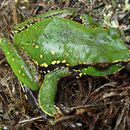Description
provided by AmphibiaWeb articles
Males usually are about 50-55 mm in length, but may grow up to 65 mm. Females grow up to about 80 mm. Its large size usually distinguishes it from other species living near it. Varies highly in color: plain, pale, brown or bright leaf-green on the dorsal side with a dark line or band of yellow and brown blotches that distinctly cut off the dorsal color. Sometimes has a dark hour-glass mark on back and usually conspicuous white ridges running down the posterior sides of limbs. Sometimes very dark, nearly black, on the dorsal side without any markings, or has green or golden dorsal side with black reticulation. All have a whitish ventral surface with a varied amount of brown blotches and a fair amount of webbing between third and fourth fingers (Menzies 1975).
- Menzies, J. I. (1975). Handbook of Common New Guinea Frogs. Wau Ecology Institute, Papua New Guinea.
- Zweifel, R. G. (1980). ''Results of the Archbold Expeditions 103. Frogs and lizards from the Huon Peninsula, Papua New-Guinea.'' Bulletin of the American Museum of Natural History, 165, 390-434.
Distribution and Habitat
provided by AmphibiaWeb articles
Ranges along central mountainous spine of New Guinea from Vogelkop Peninsula to Garaina (Zweifel 1980). Prefers vegetation along small rivers; sometimes in forests away from the water where it can be found alongside L. arfakiana (Menzies 1975).
Life History, Abundance, Activity, and Special Behaviors
provided by AmphibiaWeb articles
Call: Quiet, short, rather slow, trill lasts about half a second; frequency is limited to a narrow band, giving a somewhat musical, ringing sound. Males call while usually perched in vegetation alongside rivers and creeks, and can usually be heard above the sound of running water (Menzies 1975). Reproduction: Eggs are large and unpigmented. Tadpoles are typical of frogs that are adapted to breed in similar places; the only difference is in size (Menzies 1975).
Angiana tree frog: Brief Summary
provided by wikipedia EN
The Angiana tree frog (Litoria angiana) is a species of frog in the subfamily Pelodryadinae. It is found in New Guinea. Its natural habitats are subtropical or tropical moist montane forests and rivers.

Wikimedia Commons has media related to
Litoria angiana.
- license
- cc-by-sa-3.0
- copyright
- Wikipedia authors and editors

